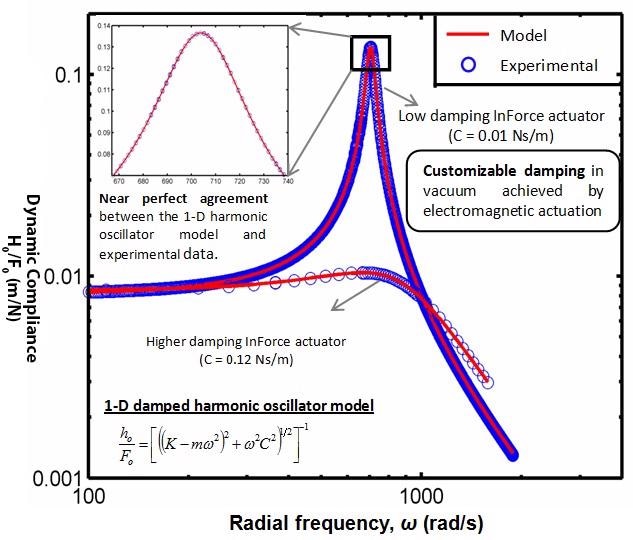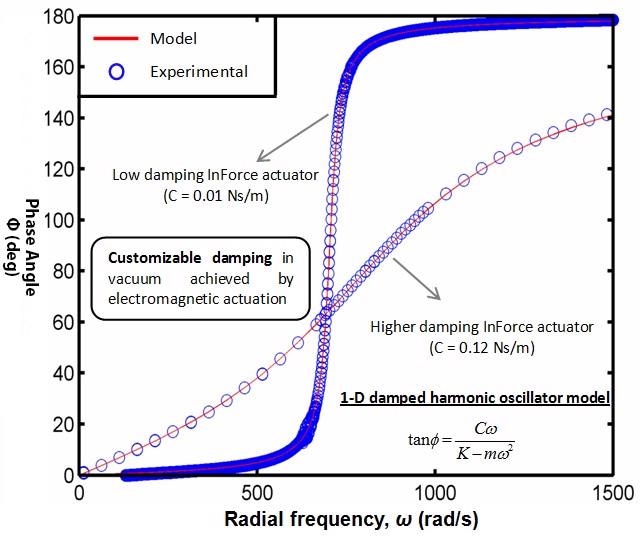Dynamic nanomechanical testing has a number of well-known advantages, which include continuous stiffness and phase angle measurement having a broad range of applications in the testing of biomaterials, thin films, rubber and polymers. Recently, the measurement of visco elastic properties of biomaterials and polymers as a function of frequency has been of particular interest.
The characterization of the instrument’s dynamic response is critical for precise measurement of the sample being tested. The dynamic characterization in vacuum of two different nanomechanical force actuators developed by Nanomechanics has a widely different dynamic behavior and that aspect is detailed in this article.
The experimental results have been found to closely match a simple, single-dimension harmonic oscillator model, hence enabling accurate dynamic characterization of samples by simple subtraction of instruments’ contribution.
Model and Experimental Details
The dynamic behavior of force actuators is described by a simple single-dimensional forced-damped harmonic oscillator model. Under the assumption of single-dimensional oscillation, the model offers the dynamic compliance (h0/F0) and phase angle (Φ) between the force and displacement as a function of oscillation frequency (ω), mass (m), damping (C) and stiffness (K) of the oscillator.
This experiment helped determine the dynamic compliance and phase angle in free space of two different force actuators across a wide range of frequencies inside a scanning electron microscope (SEM) at a vacuum level of 5.0 x 10-5 Pa.
Results
The measured dynamic compliance as a function of radial frequency for high-damped and low-damped inforce actuator is shown in Figure 1.
The single-dimensional harmonic model predictions are also shown for comparison. An excellent match is seen between the experimental data and model predictions over a wide range of frequencies. Furthermore, the experimental data matches the model equally well for the high damped and the low damped actuator. Similar results can be observed for the phase angle as a function of frequency as shown in Figure 2. These results do not just show the ability to tune the damping in the force actuators but also to maintain one-dimensional harmonic oscillation over a wide range of frequencies.

Figure 1. Dynamic compliance as a function of frequency for high damped and low damped InForce actuators along with model predictions

Figure 2. Phase angle as a function of frequency for high damped and low damped InForce actuators
Summary and Conclusions
It was found that the dynamic behavior of InForce actuators are close to the single-dimensional forced-damped oscillator model over a wide range of frequencies. The experimental results match the model predictions equally well for two different actuators with considerably different damping. The excellent match between the experimental results and the model enables accurate characterization of dynamic behavior of any sample by simple subtraction of the contribution of the instruments.
Nanomechanics, a KLA Corporation company, has extensive expertise in nanoindentation and nanomechanical characterization. Nanomechanics' principal mission is to enable our customers to evaluate and understand the mechanical performance of their materials on the micro- and nano-scales.
With field experts in nanomechanical testing, data acquisition, system integration, and software development on our staff, Nanomechanics is well positioned to provide you with the most accurate results along with leading edge characterization.

This information has been sourced, reviewed and adapted from materials provided by Nanomechanics.
For more information on this source, please visit Nanomechanics.